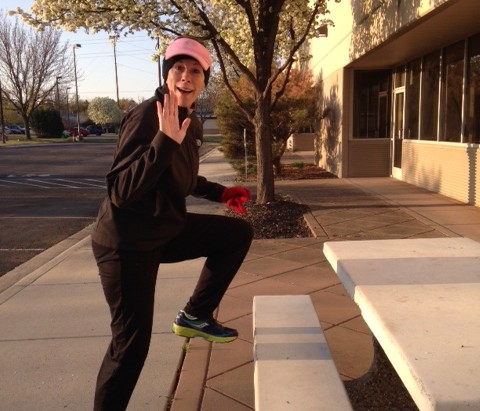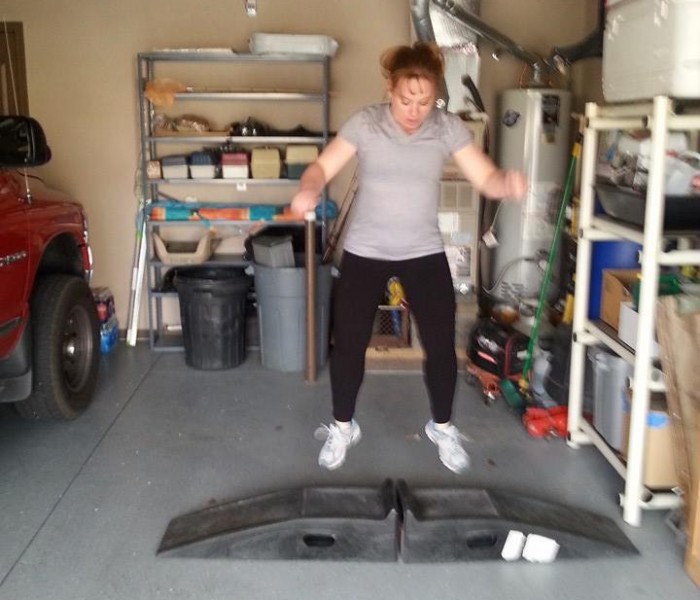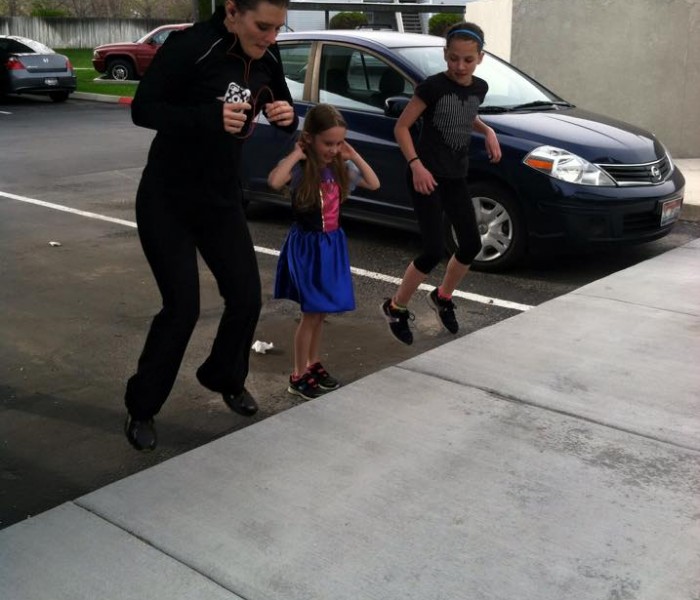https://www.girlsgonestrong.com/
It’s no secret that working out and strength training can have positive effects on our mental health. Exercise can reduce anxiety and depression. 1,2 It can also contribute to increased self-confidence and help us feel more at-home in our bodies.
Transgender individuals tend to struggle with depression and anxiety at higher rates than the general public, due to the increased discrimination, stigma, lack of acceptance, and abuse that they often face. 3, 4 So it should follow that transgender folks are eager to come into the gym as part of their self-care and wellness routines, to reap those same benefits so many people enjoy, right?
Yet… it’s not quite that simple.
Harassment and Discrimination
A lot of people worry when they first visit a gym, and at the root of much of that worry is their fear of judgment from others.
Will everyone else be super fit?
Will it be obvious that I don’t know what I’m doing?
Will my body be ridiculed, or will my body type be noticeably different?
Am I going to be the only woman in the weight room, or the only person of color?
Do I belong here?
 Daye, a trans woman, experiences a lot of anxiety going to the gym. She is only comfortable going with a friend, and avoids the locker rooms and bathrooms due to fear of being outed.
Daye, a trans woman, experiences a lot of anxiety going to the gym. She is only comfortable going with a friend, and avoids the locker rooms and bathrooms due to fear of being outed.
Going to the gym, says Daye, brings with it “the intimidation and fear of entering a space that doesn’t feel like it’s for me.”
Transgender and gender nonconforming folks may have even more anxiety about training in a gym than cisgender people do, and lot of that anxiety centers around locker room and bathroom access. (If these terms are new to you, please see this article for some basic information about gender identity.)
According to the 2015 U.S. Transgender Survey by the National Center for Transgender Equality, the majority of transgender respondents reported facing frequent harassment when using bathrooms in public places. 5
More than half (59 percent) avoided using a public bathroom in the past year due to fear of confrontation, being denied use of the facilities, or even physical or sexual assault.
Nearly one-third (31 percent) experienced discrimination, harassment, or assault while trying to access a place of public accommodation, meaning places that provide services to the public like stores, restaurants, hotels, and yes, gyms.
Tre, a transgender male, shares an experience he had while transitioning: “…there was an aggressive, muscular guy utilizing three weight benches on a day when the gym was very crowded,” he says. “I cleared away his weights so I could get a set in while he was using another bench. He started yelling transphobic and homophobic things at me, making a scene in front of all the gym patrons, and eventually threatened to follow me home and beat me up.”
Besides the threat of physical abuse, Tre’s worries largely centered around locker room and bathroom access. “Most of my gender-related issues at commercial and semi-private gyms have involved locker room access,” he says. “In the early stages of my transition when I still self-identified as female yet I was presenting and often perceived as male, I felt generally unwelcome in the women’s locker room.”
“Women… would ask me what I was doing in there, why I was in the women’s locker room, or they’d flat-out tell me to get out. When I started hormone therapy and identifying as male, I stopped going to the gym altogether because I didn’t want to make people uncomfortable in the women’s locker room, and I was afraid of using the men’s locker room.”
Mirroring Tre’s experience, one in five transgender people did not use at least one type of public accommodation in the past year because they feared they would be mistreated. 5
While these statistics are quite high, this data was collected before transgender restroom use became the subject of intense and often harmful public scrutiny in the national media and government.
Transgender people are not pretending to be something they’re not in order to victimize women and girls in public spaces.
 The reality is that anti-discrimination protections allowing transgender people to use the facilities that correspond with their gender identity have been around for years, and there is no evidence that this leads to attacks in public facilities. 6
The reality is that anti-discrimination protections allowing transgender people to use the facilities that correspond with their gender identity have been around for years, and there is no evidence that this leads to attacks in public facilities. 6
In fact, transgender people are more likely to be the victims of assault in restrooms. 7,8 Really, they just want to use restrooms — and the locker rooms — in peace and anonymity like everyone else.
Caleb, a transgender male who trains in a university gym, shares: “I am always low-key worried that I may get harassed in the locker room. I do change openly… and though I realize it’s incredibly unlikely, I fear somebody may notice and recognize my top surgery scars and question my right to be in the men’s locker room.”
Even Janae Marie Kroc, world record-holding powerlifter and bodybuilder, sometimes experiences discomfort with accessing gym bathrooms and locker rooms as a transgender female and genderfluid/nonbinary person.
 Though people usually know who she is in most gyms, she still experiences “lots of stares and some level of awkwardness or people being a little uncomfortable.”
Though people usually know who she is in most gyms, she still experiences “lots of stares and some level of awkwardness or people being a little uncomfortable.”
Janae describes how she changed her routine to avoid using gym locker rooms: “Typically I had to change before heading to the gym and couldn’t shower until I returned home. I tried hard to use the restroom right before leaving for the gym, because I did not feel comfortable using either of the restrooms designated as male or female due to fear of complaints from other patrons.”
She said that small “Family” locker rooms were helpful, and mostly used by individuals who needed the privacy.
Trans-Friendly Gyms Do Exist
Some gyms are making an intentional effort to be welcoming to people who span the gender spectrum. Having at least one gender-neutral private bathroom or changing area is key, but that’s just the beginning.
 Morgan Vozobule is a full-time coach at CrossFit Center City and Owner of Liberty Barbell Club in Philadelphia. She describes the gym as being “a haven for members from all walks of life.” Says Morgan: “Regardless of previous athletic experience, our gym recognizes that trying the things you’ve never done before can be a deeply frightening experience. We have built this gym knowing that healthy people are defined by not only their bodies- but their relationships, their minds, and their sense of belonging.”
Morgan Vozobule is a full-time coach at CrossFit Center City and Owner of Liberty Barbell Club in Philadelphia. She describes the gym as being “a haven for members from all walks of life.” Says Morgan: “Regardless of previous athletic experience, our gym recognizes that trying the things you’ve never done before can be a deeply frightening experience. We have built this gym knowing that healthy people are defined by not only their bodies- but their relationships, their minds, and their sense of belonging.”
Asked how the gym is trans friendly and competent, Morgan says “Not only do our gym members represent the wide spectrum of LGBTQ athletes, but our staff does as well …We are moving away from the conventional idea of gendered weight recommendations, we host a free monthly trans-friendly CrossFit class called Strength in Numbers, and above all, we have created a welcoming and incredibly diverse group of members that are ecstatic to share their safe space with everyone else.”
In addition, the entire coaching staff at CrossFit Center City completed an introductory education program. “The training covered trans-inclusive language and practices, with a specific focus on the challenges that trans athletes may face,” says Morgan. “As a result, we as a collective staff can better understand the difference between gender identity and sexual orientation, appropriate language and definitions, the disproportionate marginalization the trans community faces, and how to be a better allies.”
The response to CrossFit Center City’s Strength in Numbers class has been positive. “The attendance from our own members, other affiliate members, and people who have never stepped foot in a gym before has been tremendous,” Morgan says. “Strength in Numbers has been an attempt to cultivate something much larger than a place for people to work out.”
 Liberation Barbell in Portland, OR rejects the common fitness industry message that “our bodies are never enough — or more commonly — that they are too much.” Lacy Davis, who co-owns Liberation Barbell with Christina Cabrales, shares: “We are founded on the idea that physical fitness should be accessible to any body regardless of age, race, ability, gender identity, sexuality, current health, or size.” She adds that Liberation Barbell approaches fitness “through a lens of anti-oppression and with an aim to always grow and better serve the various communities that thrive in our space.”
Liberation Barbell in Portland, OR rejects the common fitness industry message that “our bodies are never enough — or more commonly — that they are too much.” Lacy Davis, who co-owns Liberation Barbell with Christina Cabrales, shares: “We are founded on the idea that physical fitness should be accessible to any body regardless of age, race, ability, gender identity, sexuality, current health, or size.” She adds that Liberation Barbell approaches fitness “through a lens of anti-oppression and with an aim to always grow and better serve the various communities that thrive in our space.”
This means that at her gym, they take the time to ask trans clients what they might like to see, and to continuously educate themselves about the actual experiences of trans people. “It is extremely important to take a moment to educate ourselves and listen.” Assuming that she and her co-owner will sometimes make mistakes, one of their core policies is “to constantly be teachable.”
“Trans and gender nonconforming people deserve to feel at home in their bodies, just like the rest of us! To me, it seems if we are excluding people from the opportunity to strengthen themselves, then we are actively screwing up,” says Lacy.
 Nathalie Huerta, owner of The Queer Gym in Oakland, CA, would agree. Her gym is “a body-positive gym space free of homophobia, transphobia, and fatphobia.” Like Lacy Davis, she describes learning as an important part of her gym’s process to be transgender competent. “We genuinely wanted to learn,” she says, “and celebrate all of our queer community, not just parts of it.”
Nathalie Huerta, owner of The Queer Gym in Oakland, CA, would agree. Her gym is “a body-positive gym space free of homophobia, transphobia, and fatphobia.” Like Lacy Davis, she describes learning as an important part of her gym’s process to be transgender competent. “We genuinely wanted to learn,” she says, “and celebrate all of our queer community, not just parts of it.”
“We are the first [queer gym] in the industry… so it took us being proactive about seeking the answers to our questions and learning what was important for people under the entire queer umbrella to have in a gym space,” Nathalie says. “We spoke to members and different organizations and got the staff trained.
From there, we realized our membership base also needed this information, so we created a workshop called Queer 101. We require the staff to attend, but also open it up for our members and the community to come learn.”
Nathalie says the response to her gym has been overwhelmingly positive.“I thought someone would smash my windows or tag up our gym, but luckily [knock on wood] none of that has ever happened!”
Creating a Trans-Inclusive Gym Environment
A few key points came up repeatedly among trans gym members and the owners of transgender friendly gyms.
- It is imperative that gym owners educate themselves and their staff on the discrimination trans people may face in general, and especially on the discrimination they may face in a gym environment.
- Provide single stall or gender neutral bathrooms, locker rooms, and changing areas. At least one private changing area goes a long way to making trans folks feel that they can change safely at the gym.
- Avoid delineating “men’s” and “women’s” workouts or weights.
- Have a zero-acceptance policy against harassment that includes harassment based on gender identity. State this policy explicitly on your gym’s website.
- Don’t be afraid to learn from your mistakes. “I think people believe that to invite trans and gender nonconforming people into their gyms they must be perfect, but I disagree,” says Lacy. “I think we must take care to learn and be humble when we screw up.”
Creating a gym that is welcoming to transgender athletes is not about providing special rights and privileges to a group of people. It is about leveling the playing field so that people can come into a gym environment and not worry about experiencing discrimination or difficulty specifically because they’re transgender.
“I think that starting a gym routine can be intimidating for anyone,” says Morgan, “and the pervasive, systematic isolation that members of the trans community face every day make it that much more daunting… it is our duty as wellness professionals to give each individual the tools necessary to pursue their own fitness journey.”  Morgan feels strongly that gym owners can be the pioneers of “creating more inclusive establishments that broaden our community and strengthen our connections to each other.”
Morgan feels strongly that gym owners can be the pioneers of “creating more inclusive establishments that broaden our community and strengthen our connections to each other.”
“It’s every person’s right to have access to a space where they’re not concerned about being physically, sexually or emotionally harassed while they’re just trying to get healthier,” adds Nathalie.
“If we limit the access of trans and gender non conforming members, we are essentially denying them the right to health, wellness, and fitness.”
References:
- Paluska SA, Schwenk TL. Physical activity and mental health: current concepts. Sports Medicine. 2000;3:167-180.
https://link.springer.com/article/10.2165/00007256-200029030-00003 - O’Connor PJ, Herring MP, Carvalho A. Mental health benefits of strength training in adults. American Journal of Lifestyle Medicine. 2010;4(5):377-396.
http://journals.sagepub.com/doi/abs/10.1177/1559827610368771 - Schreiber K. Why Transgender People Experience More Mental Health Issues. Psychology Today. December 2016. https://www.psychologytoday.com/blog/the-truth-about-exercise-addiction/201612/why-transgender-people-experience-more-mental-health.
- Robles R, Fresán A, Vega-Ramirez H, et al. Removing transgender identity from the classification of mental disorders: a Mexican field study for ICD-11. The Lancet Psychiatry. 2016 Sep. 9(3):850-859.
http://www.thelancet.com/journals/lanpsy/article/PIIS2215-0366(16)30165-1/abstract - James, SE, Herman, JL, Rankin, S, Keisling, M, Mottet, L, & Anafi, M. Executive Summary of the Report of the 2015 U.S. Transgender Survey. Washington, DC: National Center for Transgender Equality. 2016.
http://www.transequality.org/sites/default/files/docs/usts/Executive%20Summary%20-%20FINAL%201.6.17.pdf - 15 Experts Debunk Right-Wing Transgender Bathroom Myth. Media Matters for America. https://www.mediamatters.org/research/2014/03/20/15-experts-debunk-right-wing-transgender-bathro/198533. Published March 19, 2014.
- Brady J. When A Transgender Person Uses A Public Bathroom, Who Is At Risk? NPR. Published May 15, 2016. http://www.npr.org/2016/05/15/477954537/when-a-transgender-person-uses-a-public-bathroom-who-is-at-risk
- Herman, JL. Gendered Restrooms and Minority Stress: The Public Regulation of Gender and its Impact on Transgender People’s Lives. Journal of Public Management & Policy. 2013 19(1):65-80.
http://williamsinstitute.law.ucla.edu/wp-content/uploads/Herman-Gendered-Restrooms-and-Minority-Stress-June-2013.pdf
The post Creating Welcoming Gym Environments for Trans and Gender Nonconforming Athletes appeared first on Girls Gone Strong.
Filed under: Fitness

 For now classes are 6pm and 640pm at 2840 Wildwood st in the Boise Cloggers studio.
Book your class NOW!
click this ==>
For now classes are 6pm and 640pm at 2840 Wildwood st in the Boise Cloggers studio.
Book your class NOW!
click this ==>








